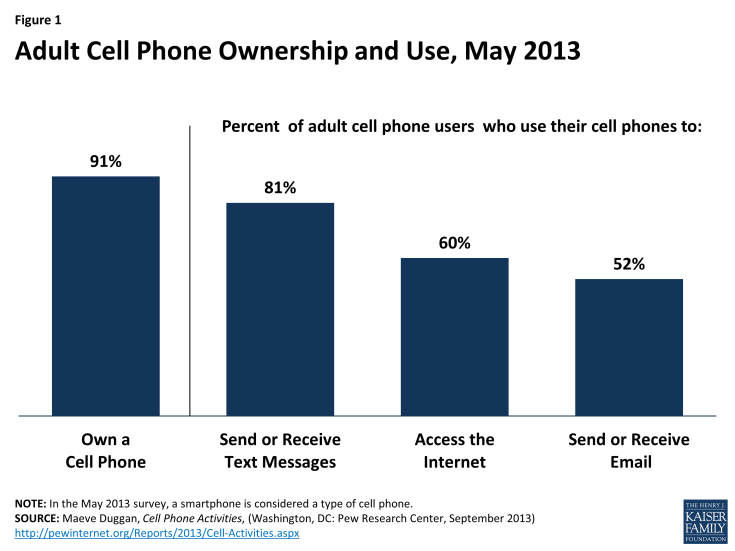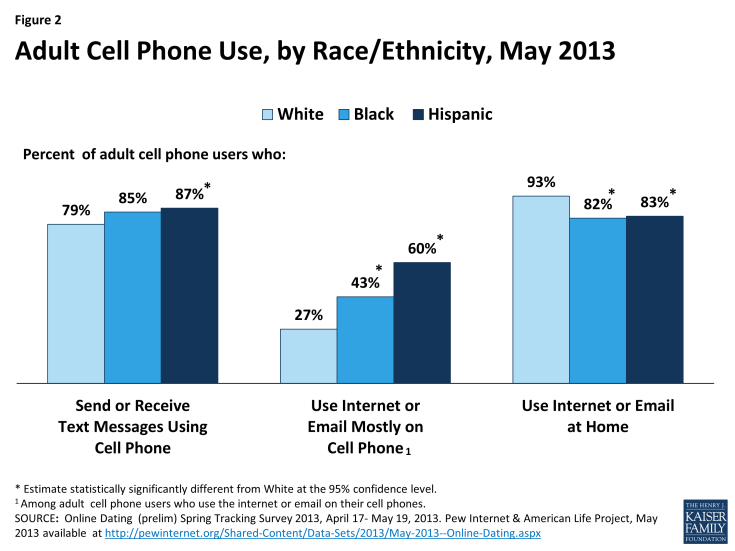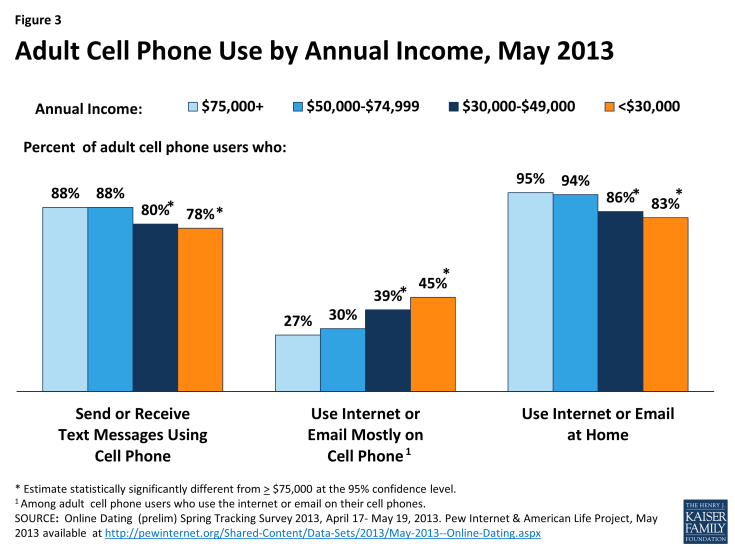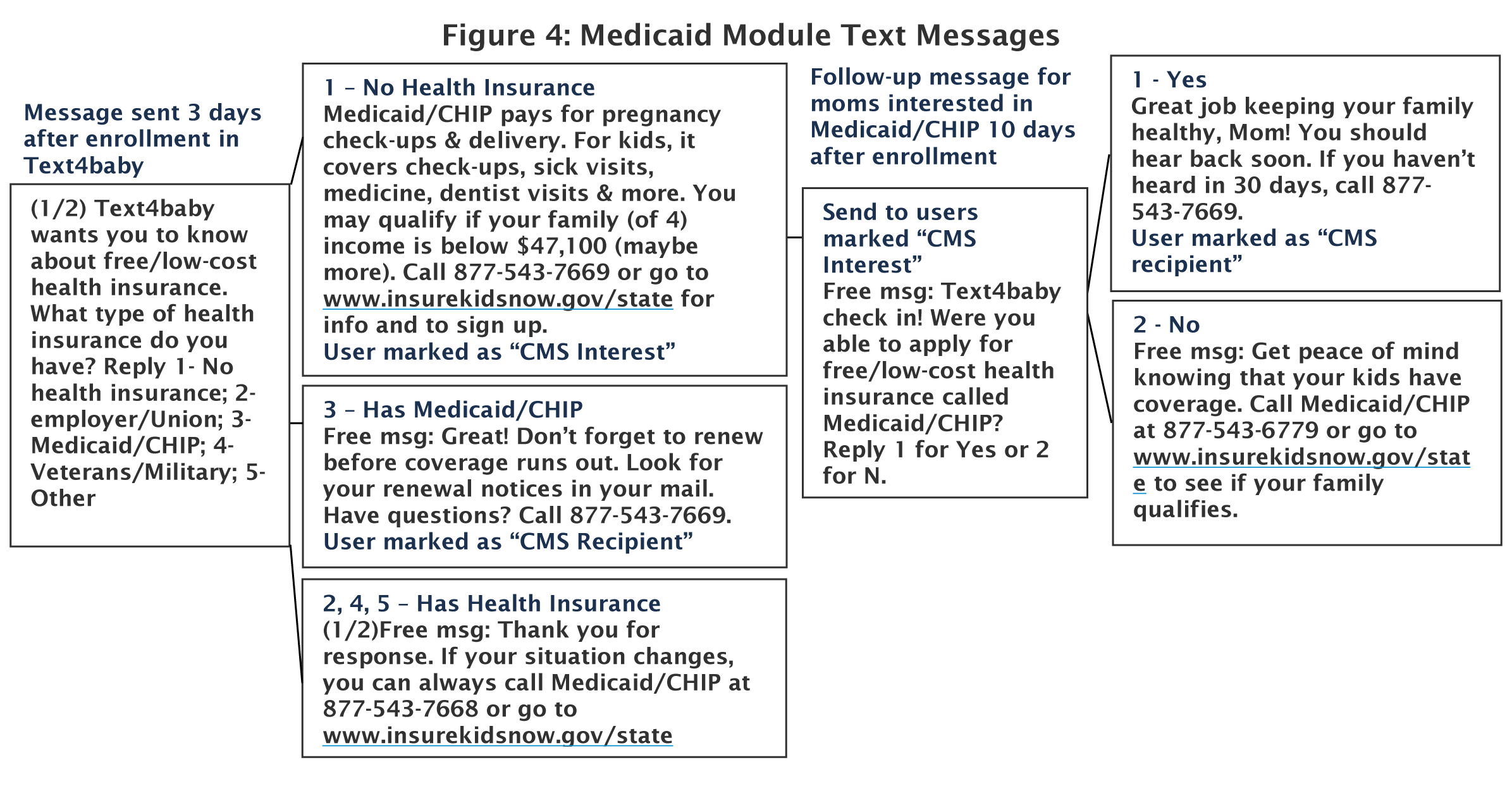Profiles of Medicaid Outreach and Enrollment Strategies: Using Text Messaging to Reach and Enroll Uninsured Individuals into Medicaid and CHIP
The 2014 Affordable Care Act (ACA) health coverage expansions provide millions of uninsured Americans a new coverage option through Medicaid or Health Insurance Marketplaces. However, effective outreach, enrollment, and retention efforts are essential for ensuring that these new coverage opportunities translate into increased coverage. Past Medicaid and CHIP experience demonstrates that a combination of broad and targeted outreach and enrollment approaches are key to reaching and enrolling eligible people, particularly hard-to-reach individuals.1 The Kaiser Commission on Medicaid and the Uninsured has previously examined a number of innovative strategies that may provide lessons for outreach and enrollment under the ACA, including providing one-on-one enrollment assistance through community health centers in Utah and using technology-based reminders to facilitate renewals of coverage in Michigan.2,3 Another potential avenue for targeted outreach is through text messaging and other mobile technology, which has become an increasingly common source of communication, particularly among low-income adults targeted by the coverage expansions. To provide greater insight into the potential role of text messaging as an outreach vehicle, this brief focuses on the use of standard cell phones and smartphones for text messages and Internet access and illustrates how one text messaging initiative, Text4baby, a free, personalized maternal child health education text messaging service for pregnant women and new mothers, is helping eligible pregnant women and their families connect to health coverage.
Use of Mobile Technology
Mobile technology includes a growing array of handheld or portable electronic devices such as cell phones, smartphones, and tablets. Adults are using these devices more frequently for a number of activities including text messaging, accessing the Internet, and conducting other Web-based activities such as online banking and accessing social media through applications.4
According to a recent study, more than nine in ten American adults (91%) owned a cell phone in 2013.5 Additionally, nearly six in ten of adults who owned a cell phone (59%) owned a smartphone, which is a type of cell phone with advanced features such as Internet and email accessibility.6 Cell phone ownership is widespread across income and demographic groups (Table 1). It is estimated that, as of May 2013, 88 percent of Hispanics, 93 percent of Blacks, and 90 percent of Whites owned cell phones. Although adults with higher incomes and educational attainment levels are more likely to own a cell phone than those with lower incomes and education levels, cell phone ownership is still high among low-income adults and those with lower education. Nearly nine in ten adults (86%) with annual income below $30,000 and 83% of adults with less than a high school education owned a cell phone as of May 2013. Cell phone ownership is also high among adults across age groups and urban, rural, and suburban contexts.
| Table 1: Cell Phone Ownership Among Adults in the United States, May 2013 | |
| All Adults | 91% |
| Gender | |
| Men | 93% |
| Women | 88% |
| Age | |
| 18-24 | 97% |
| 25-34 | 97% |
| 35-44 | 96% |
| 45-54 | 92% |
| 55-64 | 87% |
| 65+ | 76% |
| Race/Ethnicity | |
| White | 90% |
| Black | 93% |
| Hispanic | 88% |
| Educational Attainment | |
| Less than High School | 83% |
| High School Graduate | 88% |
| Some College | 92% |
| College+ | 95% |
| Annual Household Income | |
| Less than $30,999 | 86% |
| $30,000-$49,999 | 90% |
| $50,000-$74,999 | 96% |
| $75,000+ | 98% |
| Urbanity | |
| Urban | 92% |
| Suburban | 91% |
| Rural | 85% |
|
SOURCE: Lee Rainie, Cell Phone ownership hits 91% of adults (Washington, DC: Pew Research Center: June 6, 2013), http://www.pewresearch.org/fact-tank/2013/06/06/cell-phone-ownership-hits-91-of-adults/
|
|
Adults use their cell phones for a variety of tasks, including text messaging and as their primary way to access the Internet. More than 4 in 5 adult cell phone owners (81%) use their cell phone to send or receive text messages, including 87 percent of Hispanics and 85 percent of non-Hispanic Blacks.7 Moreover, data suggest that 99 percent of text messages are read, with 91 percent of them read within three minutes8 Six in ten cell phone users (60%) access the Internet on their phones and over half (52%) use their cell phones to send or receive email (Figure 1). More than one in three cell phone users (34%) who use their cell phones for Internet or email report that, when using the Internet, they do so mostly on a cell phone instead of through another device like a desktop, laptop, or tablet computer. The use of both text messaging and cell phones to access the Internet has risen dramatically in recent years, especially as smartphones have become more popular. 9
Low-income adults and people of color who are cell phone owners are particularly likely to use their phone as their primary way to access the Internet. Among adult cell phone owners, Hispanics are significantly more likely than Whites to use their cell phones to send or receive text messages (Figure 2). Hispanic and Black adults are also significantly more likely than their White counterparts to use their cell phones to access the Internet and to do so mostly on a cell phone instead of on another device such as a computer, laptop, or tablet. Similarly, lower income adults are more likely than those at higher incomes to say that they mostly access the Internet through their cell phone. Moreover, compared to Whites and those with higher family income, Blacks and Hispanics and low-income earners are less likely to use the Internet or email at home (Figure 3).
Using Text Messaging as an Outreach and Enrollment Tool: The Text4Baby Example
There has been growing interest in using text messaging and mobile technology in health care. For example, a number of insurance companies have developed mobile applications that allow beneficiaries to search for physicians or facilities, view and share member health plan information, or contact a provider about a health care need.10 Researchers have also noted the potential value of cell phones and other mobile technology as a means to improve patient compliance through text message reminders and to help patients communicate with their clinicians and track and manage chronic conditions.11 Some initiatives are also exploring the use of text messaging to reach and enroll more people in health coverage. For example, as highlighted in a previous outreach and enrollment strategy profile, the Michigan Primary Care Association achieved success increasing retention through an innovative text messaging strategy that reminds Medicaid and CHIP enrollees about the need to renew Medicaid coverage and offer renewal assistance to families.12 Similarly, the National Alliance for Hispanic Health launched a text messaging service called the Buena Salud Club to provide free, bilingual health and health coverage information to Hispanic consumers through text messaging. 13 Beginning in 2012, Text4baby, a personalized maternal and child health program, also launched a text messaging outreach and enrollment campaign to connect more pregnant women and their families to Medicaid and CHIP. Early experiences from this initiative are discussed further below.
Text4baby is a free, personalized maternal child health education program that uses text messaging to provide health and safety information and support to pregnant women and new mothers. The program is a public-private partnership that conducts outreach through over 1,100 promotional members including federal agencies, state and local health departments, Medicaid agencies, health plans, hospital networks, and the media.14 Since Text4baby launched in in February 2010, nearly 680,000 pregnant women and new mothers have enrolled in the program.15 External studies of Text4baby also suggest that it has been effective in reaching its target audience of individuals from underrepresented groups and people of lower economic statuses.16 Women who enroll in the program receive three free text messages a week, timed to their due date or their baby’s birth date, through pregnancy and up until the baby’s first birthday. Messages cover a range of health and safety topics. Recently, Text4baby incorporated use of a series of text messages, referred to as the “Medicaid module,” which were designed to increase enrollment of uninsured pregnant women and their families into Medicaid and CHIP.
Text4Baby and the Medicaid Module
In February 2012, Text4baby partnered with the Connecting Kids to Coverage initiative of the Centers for Medicare and Medicaid Services to drive enrollment in Medicaid and CHIP through a series of interactive text messages. As part of this “Medicaid module,” three days after enrolling in Text4baby, individuals are asked about their type of health coverage. Those who respond with Medicaid or CHIP are then texted a supportive message and information on how to renew their coverage. Those who are uninsured are texted information about Medicaid and CHIP eligibility and how to enroll. They also receive a follow-up text seven days later asking if they applied for coverage (Figure 4). Women who respond they are enrolled in Medicaid or CHIP or applied for Medicaid or CHIP are reminded to renew their coverage. Nearly half (47%) of the over 110,000 women who enrolled in Text4baby between the end of December 2012 and August 2013 responded to the first question of the Medicaid module, and about 13 percent of these women reported they were uninsured.17
Experiences with the Text4baby Medicaid Module
In late summer 2013, the Kaiser Commission on Medicaid and the Uninsured and PerryUndem Research and Associates conducted structured telephone interviews with 43 women enrolled in Text4baby to take a qualitative look at the impact of the Medicaid module. All interview respondents were uninsured themselves or had at least one uninsured child when they enrolled in Text4baby and recalled receiving the text messages in the Medicaid module. The interviews were conducted in English and Spanish. Key findings are discussed below:
Text4baby respondents included young, low- and moderate-income women with diverse racial and ethnic backgrounds. Nearly all respondents were between ages 18 and 35 years old, with many between 18 and 24 years old. Respondents included both those who already had children in the home and those who did not yet have any children in the household. They also included women of diverse racial and ethnic backgrounds and immigration statuses, with a number speaking a language other than English in the home. Almost all respondents reported having household income of less than $40,000, with a number reporting income below $20,000 per year.
Cell phones are a key source of connection to the Internet for respondents. Many of the Text4baby respondents reported that they primarily connect to the Internet through their cell phone. In a number of cases, respondents who said they primarily connect to the Internet through their phone indicated that they do not have access to a computer at home or work. A smaller number of respondents reported mostly connecting to the Internet through the computer and several said they use a cell phone and computer equally.
Most respondents had limited knowledge of Medicaid and CHIP when they signed up for Text4baby. At the time they enrolled in Text4baby, most said they had never been covered by Medicaid or CHIP or tried to sign themselves up for Medicaid or CHIP in the past. However, some reported that they knew a good amount or a lot about the programs, with a number having been previously enrolled in Medicaid and CHIP.
Many respondents said they sought out additional information about Medicaid and CHIP after receiving Text4baby’s messages about health coverage. Some visited the Insure Kids Now website through their phone or computer or called the Insure Kids Now toll free number. Some tried to learn more about coverage by talking to a health care provider, family and friends, someone from Medicaid, CHIP, or another government office, or a trusted individual in their community.
A number of the respondents said they applied for Medicaid or CHIP for themselves or an uninsured child after receiving Text4baby’s messages about health coverage. Most respondents who had applied had successfully enrolled by the time of the interview. However, several respondents were still waiting for an eligibility determination. Most respondents who reported applying for Medicaid and CHIP indicated that Text4baby’s messages about health coverage were an important factor in their decision to apply for Medicaid and CHIP. Moreover, regardless of whether they applied for Medicaid and CHIP, nearly all respondents said they found the Text4baby messages useful and said that they would like to receive more text messages about health insurance in the future.
Looking Ahead
With the continued rise in the use of mobile technology across the population, including lower-income and diverse groups, text messaging can serve as a useful vehicle to reach and communicate with uninsured individuals. Experience with the Text4baby Medicaid module shows that individuals found text messages about health insurance to be useful and that the messages helped spur them to seek out additional information about health coverage and apply for coverage. Looking ahead, as outreach and enrollment efforts for the ACA coverage expansions continue, these findings suggest that text messaging could be an effective outreach and education tool. Other experience suggests that text messaging may also be an effective tool to facilitate renewals of Medicaid and CHIP coverage. Given that some individuals primarily rely on cell phones to connect to the Internet, it may be useful to explore options that would enable individuals to apply for and renew health coverage directly through their phone. Overall, with the continued rise of use of mobile technology, it will be important to continue to explore its potential uses in enrolling and maintaining health coverage.
This issue brief is part of a Kaiser Commission on Medicaid and the Uninsured series of profiles on Medicaid and CHIP Outreach and Enrollment Strategies. The authors would like to extend their appreciation to Text4baby for providing data used in this report.
Endnotes
See: Kaiser Commission on Medicaid and the Uninsured. “Key Lessons from Medicaid and CHIP for Outreach and Enrollment Under the Affordable Care Act.” June 2013.
Kaiser Commission on Medicaid and the Uninsured. “Profiles of Medicaid Outreach and Enrollment Strategies: One-on-One Assistance Through Community Health Centers in Utah.” March 2013.
Kaiser Commission on Medicaid and the Uninsured. “Profiles of Medicaid Outreach and Enrollment Strategies: Helping Families Maintain Coverage in Michigan.” May 2013.
Maeve Duggan, Cell Phone Activities, (Washington, DC: Pew Research Center, September 2013) http://pewinternet.org/Reports/2013/Cell-Activities.aspx
Ibid.
Ibid.
Ibid.
Simple Texting, Why is Text Message Marketing So Effective? (New York City, NY: Simple Texting.com, June 2012),
Ibid.
Health4Me Mobile Application. United Health Care. http://www.uhc.com/individuals_families/member_tools/health4me_mobile_application.htm
Steinbuhl, S., E Muse, and E.J. Topol. “Can Mobile Health Technologies Transform Health Care?” 310 (2013) 22. doi: 10.1001/jama.2013.281078.
Kaiser Commission on Medicaid and the Uninsured. “Profiles of Medicaid Outreach and Enrollment Strategies: Helping Families Maintain Coverage in Michigan.” May 2013.
Falcon, Adolf. “Buena Salud: Hispanics and the Future of the Southern U.S.” Presented at the GIH Meeting on Latinos in Health Care: Assets and Opportunities in the South. West Palm Beach, FL, May 10, 2013. http://www.gih.org/files/Falcon.pdf
Murphy, Kathleen. “Harnessing the Power of Mobile for Maternal and Child Health: The Text4baby Program.” Presentation to the University of Maryland Health Sciences and Human Services Library’s Embracing mHealth: Mobilizing Healthcare Symposium.” October 22, 2013. Available at: https://archive.hshsl.umaryland.edu/bitstream/10713/3519/1/Murphyumd%20conference%2010%2022%2013.pdf
Text4babyEnrollment Data as of Feburary 8, 2014 available at https://Text4baby.org/index.php/partner-resources/105-Text4baby-enrollment-data
California State University San Marcos National Latino Research Center and University of California San Diego (2012). Maternal and Newborn Health: Text4baby San Diego. Evaluation Overview: October 2011-October 2012. Available: http://www.csusm.edu/nlrc/documents/report_archives/Text4Baby_SanDiego_Evaluation_Overview.pdf. Data collected via three surveys implemented October 2011 - October 2012. Total sample size = 626. Total respondents who provided income level = 480.
Text4Baby. “Connecting to Health Care and Coverage: Preliminary Results from Text4baby Medicaid/CHIP Module.” Available at: http://Text4baby.org/templates/beez_20/images/HMHB/t4b%20medicaid%20module%20factsheet%2010%2017%2013.pdf






